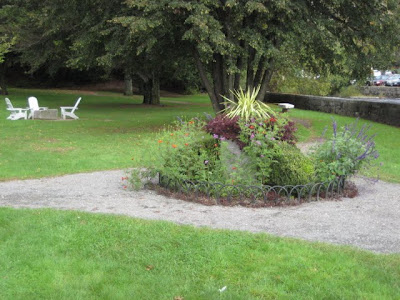
The Water Parterre at Villa Gamberaia
I had the good fortune to attend the Chelsea Flower Show on two occasions. Each time, I was struck by the simple modern design of two foreigners: Swedish designer, Ulf Nordfjell, in 2007 and the Italian garden designer, Luciano Giubbilei last May.
Nordfjell's garden was a tribute to Carl Linnaeus and used a Swedish steel, timber and granite elements in a very simple but elegant design. The plant palette consisted of plants known to be cultivated by Linnaeus and plants commonly grown in Swedish gardens. The Giubbilei garden was equally simple and elegant with a pool, bamboo pavilion and sculpture by Peter Randall-Page. He used pink, maroon and brown flowers planted in romantic drifts to great effect.
Both designers have published books chronicling their work. Ulf Nordfjell: Fourteen Gardens and The Gardens of Luciano Giubbilei were coincidentally both published in English last year. I found it fascinating that they both site Villa Gamberaia, the Tuscan masterpiece, as an inspiration.
Nordfjell noted that at Villa Gamberaia "I found what I have often missed in other gardens: architecture, design, and the art of the garden, all unified by the stylistic ideals of the Renaissance man." He goes on to say that the villa "despite its age, feels like a modern and cohesively designed garden." Nordfjell fantasied "in my mind's eye, I find it irresistible to replace today's well-manucred lawns with ethereal beauty of the Tuscan landscape, creating an intimate tribute to nature from its own wildflowers: meadows of grape hyacinths, primulas. daisies and salvias, framed by formal hedging. This would, if such a thing is possible, enhance the genius of the Renaissance garden still further, forming a meeting between garden and the natural landscape, created by our human longing for beauty."
In his late teens, Giubbilei spent some time volunteering at Villa Gamberaia, being mentored by the head gardener, Silvano, who had worked there since the end of the Second World War. When Giubbilei left the villa, "Silvano presented him with a black-and-white record of the garden, a book that would prove a significant influence once his design career was under way. The atmospheric photographs by Balthazar Korab depicted both the architecture and mood of the garden: deep, rich shadows played on intensely lit surfaces, their textures almost tangible." Using these photographs as a model, Giubbilei "wanted to seduce people into entering gardens using the architecture of planting, the texture of the surfaces and the arrangement of sculpture, containers and furniture. His intention was never to imitate but to explore, to understand the sentiment behind the garden and the intensely motivating images."
During a family trip to Italy, I visited Villa Gamberaia in 2000. I was struck by the simplicity of the design and the intimacy of the scale of the garden. I learned the importance of having both shade and light in the garden and the clever use of terracing to divide spaces on a sloped site. I realized that I long for a design that is well-articulated and doesn't attempt to do too many things at once. It reminds me of the advice of an English professor who encouraged us "to say it, say it and say it again." The same clarity of intention is true about effective garden design.
Both of these designers have helped me distill what I found so alluring about Villa Gamberaia. Luciano Giubbilei has reminded me of the importance being influenced by other gardens and art but not to copy them verbatim and Ulf Nordfjell has galvanized in my mind the importance of well-chosen plants to create a desired effect within the confines of a strong design.



















































